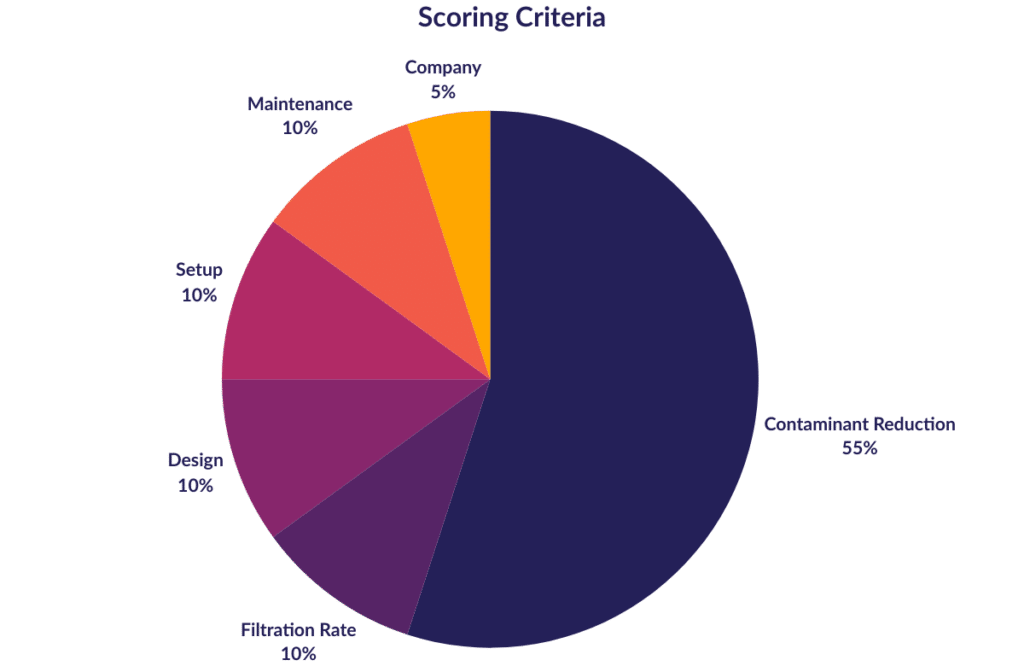We’ve shortlisted five of the best reverse osmosis systems in 2025 based on our lab data, analysis, and decade of water filter testing experience.
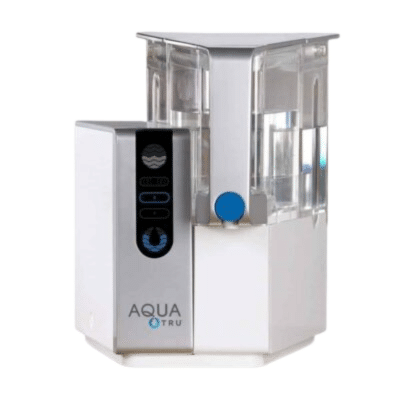
Aquatru
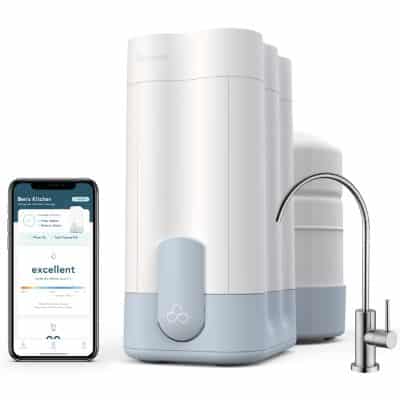
Cloud RO
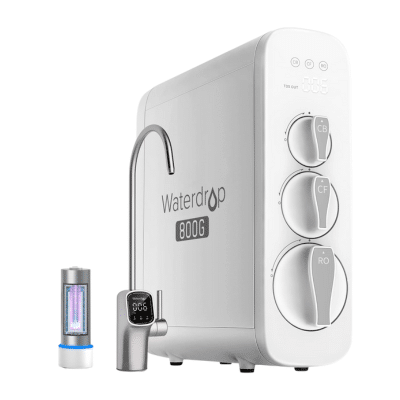
Waterdrop G3 P800
Table of Contents
Our Testing & Selection Process
The Best RO Systems of 2025
| Product | 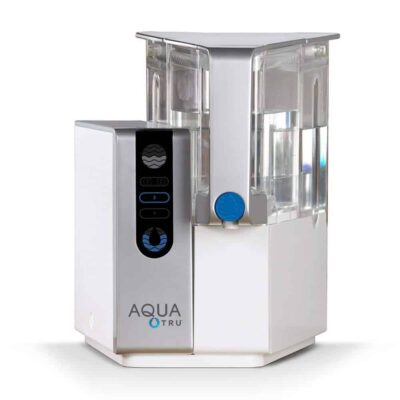 AquaTru |  Cloud RO | 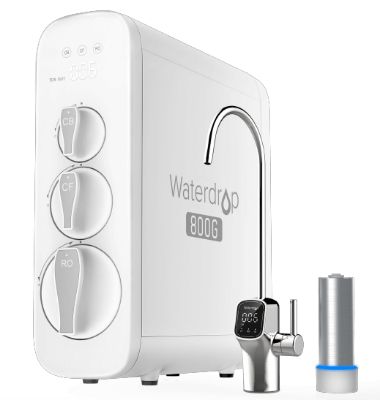 Waterdrop G3 P800 | 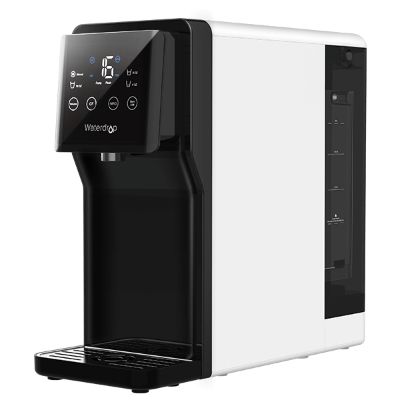 Waterdrop N1 | 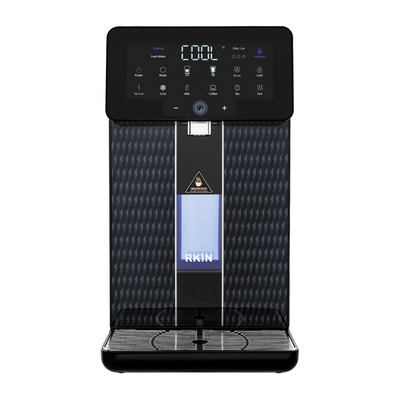 RKIN U1 |
|---|---|---|---|---|---|
| Score | 9.54 | 9.25 | 9.21 | 9.03 | 8.83 |
| Price | $449 | $749 | $999 | $299 | $749 |
| Certifications | NSF 42, 53, 58, 401, and P473 | NSF 58 | NSF 42, 53, 58 | Not Certified | NSF 58 (in progress) |
| Filter Capacity | 600 - 1,200 gallons | 500 - 1,500 gallons | 800 gallons | 550 - 1,600 gallons | 792 gallons |
| Cost per Gallon | $0.11 | $0.26 | $0.11 | $0.09 | $0.08 |
| Warranty | 1 year | 1 year | 1 year | 1 year | 1 year |
| Read Review | Aquatru review | Cloud RO review | Waterdrop G3 P800 review | Waterdrop N1 review | RKIN U1 review |
Aquatru & Aquatru Carafe

The AquaTru countertop RO system is the top-scoring reverse osmosis system out of all the units we tested. It improved our water quality more than any other system performance certified for every single contaminant that it’s listed to reduce, and has one of the best efficiency ratios we’ve seen for an RO filter. We awarded the system an overall weighted score of 9.54 out of 10.00.
Best For
Anyone looking for the best-performing countertop reverse osmosis system that’s certified for 100% of the manufacturer’s contaminant reduction claims and has a high efficiency ratio to minimize water waste.
Product Specs
| Price | $449.00+ |
| Contaminants Reduced | 83+ |
| Certifications | NSF 42, 53, 58, 401 |
| Process | Mechanical + RO + Carbon |
| Filter Capacity | 600 – 1,200 gallons |
| Annual Cost | ~$100 |
| Warranty | Lifetime |
Why It’s Best
We tested the AquaTru Classic system with our city water in Colorado. We then upgraded the VOC filter to include remineralization media (sold with the Alkaline Classic model) to introduce minerals into our RO water. The base model for the countertop system is around $450 upfront, with an added $20-$70 if you choose one of the upgraded configurations.
Removed All Contaminants with Health Effects From Our Water
The key reason why the AquaTru takes the top spot on our list is its superior contaminant reduction. In our testing, the system received the best score in this category (9.91) of all the filters we’ve tested so far.
We took samples of our water before and after purifying it in the system, then sent it for lab testing with SimpleLab Tap Score:
- The first test was with the Classic VOC filter.
- We then conducted a second with the Alkaline Remineralizing VOC filter.
Our AquaTru Classic test results showed that the system had removed 100% of all the trace levels of 11 contaminants with possible health effects detected in our water. This included fluoride, lead, and uranium, which were detected at concentrations above the lab’s Health Guideline Level.
When we conducted the Alkaline Classic test, two additional contaminants—fluoride and uranium—were detected above the HGL. Chloroform (a disinfection byproduct) was also detected at levels below the HGL. The AquaTru removed these completely.
The AquaTru completely eliminated all impurities with health effects, and its contaminant reduction score was further boosted by its IAPMO certification to NSF Standards 42, 53, 58, and 401, for the removal of all 83 contaminants that AquaTru claims to reduce. We’ll share the full list of contaminants removed by the system in the table below.
| Parameter | Type | Measurement | Pre-Filtration | Post-Filtration | % Reduction |
|---|---|---|---|---|---|
| Total THMs | Disinfection Byproducts | µg/L | 0 | 0 | #DIV/0! |
| Chloride | Inorganics | mg/L | 9.2 | 0 | -100.00% |
| Fluoride | Inorganics | mg/L | 1.5 | 0 | -100.00% |
| Nitrate (as N) | Inorganics | mg/L | 2.1 | 0 | -100.00% |
| Phosphorus | Inorganics | mg/L | 1.1 | 0 | -100.00% |
| Sulfate | Inorganics | mg/L | 7.6 | 0 | -100.00% |
| Barium | Metals | mg/L | 0.014 | 0.00E+00 | -100.00% |
| Copper | Metals | mg/L | 0.0525 | 0 | -100.00% |
| Lead | Metals | mg/L | 0.0009 | 0 | -100.00% |
| Molybdenum | Metals | mg/L | 0.0047 | 0 | -100.00% |
| Strontium | Metals | mg/L | 0.108 | 0 | -100.00% |
| Uranium | Metals | mg/L | 0.0182 | 0 | -100.00% |
| Zinc | Metals | mg/L | 0.559 | 0 | -100.00% |
| Calcium | Minerals | mg/L | 23.9 | 0.7 | -97.07% |
| Magnesium | Minerals | mg/L | 6.08 | 0.36 | -94.08% |
| Sodium | Minerals | mg/L | 9.91 | 0 | -100.00% |
| pH | Properties | - | 7.4 | 8 | 8.11% |
| Total Dissolved Solids | Properties | mg/L | 112 | 12 | -89.29% |
| Conductivity | Properties | µmhos/cm | 190 | 17.4 | -90.84% |
| Hardness (Ca,Mg) | Properties | mg/L | 84.72 | 3.23 | -96.19% |
| Hardness (Total) | Properties | mg/L | 85.79 | 3.23 | -96.23% |
| Grains per gallon | Properties | Grains | 5.02 | 0.19 | -96.22% |
| Alkalinity (as CaCO3) | Properties | mg/L | 76 | 10 | -86.84% |
| Langelier Saturation Index | Properties | - | -0.74 | -2.4 | 224.32% |
| Sodium Adsorption Ratio | Properties | - | 2.56 | 0 | -100.00% |
| Total THMs | Disinfection Byproducts | μg/L | 2.08 | 0 | -100.00% |
| Chloroform | Disinfection Byproducts | μg/L | 2.08 | 0 | -100.00% |
| Chloride | Inorganics | mg/L | 28.5 | 0 | -100.00% |
| Sulfate | Inorganics | mg/L | 8 | 0 | -100.00% |
| Nitrate (as N) | Inorganics | mg/L | 4.2 | 0 | -100.00% |
| Fluoride | Inorganics | mg/L | 0.9 | 0 | -100.00% |
| Molybdenum | Metals | mg/L | 0.0019 | 0 | -100.00% |
| Copper | Metals | mg/L | 0.31 | 0 | -100.00% |
| Barium | Metals | mg/L | 0.0228 | 0 | -100.00% |
| Strontium | Metals | mg/L | 0.135 | 0 | -100.00% |
| Uranium | Metals | mg/L | 0.0096 | 0 | -100.00% |
| Bicarbonate | Minerals | mg/L | 82.75 | 6.18 | -92.53% |
| Calcium | Minerals | mg/L | 30.5 | 0.9 | -97.05% |
| Carbonate | Minerals | mg/L | 0.08 | 14.3 | 17775.00% |
| Magnesium | Minerals | mg/L | 7.32 | 9.78 | 33.61% |
| Potassium | Minerals | mg/L | 0 | 1.1 | #DIV/0! |
| Sodium | Minerals | mg/L | 11.2 | 1.67 | -85.09% |
| Sodium Adsorption Ratio | Properties | 0.47 | 0.11 | -76.60% | |
| Conductivity | Properties | umhos/cm | 279 | 120 | -56.99% |
| Total Dissolved Solids | Properties | mg/L | 164 | 71 | -56.71% |
| Alkalinity (as CaCO3) | Properties | mg/L | 68 | 54 | -20.59% |
| pH | Properties | pH | 7.3 | 10.7 | 46.58% |
| Hardness (Ca,Mg) | Properties | mg/L | 106.3 | 42.52 | -60.00% |
| Hardness (Total) | Properties | mg/L | 106.96 | 42.52 | -60.25% |
| Grains per gallon | Properties | Grains | 6.26 | 2.49 | -60.22% |
| Langelier Saturation Index | Properties | -0.81 | 1.34 | -265.43% |
In terms of mineral loss, in our Classic test (without the alkaline filter), calcium in our water was reduced by 97%, magnesium by 94%, and chloride and sodium were both completely removed. This is a normal side effect of reverse osmosis that we hoped to remedy by replacing the VOC filter with the remineralization upgrade.
In test two, calcium was still reduced by 97.5%, but magnesium concentrations only decreased by 33%. We also saw a substantial increase in the pH of our water 7.3 to 10.7, which was a big jump from our water’s 8.0 pH when using the non-alkaline model. This shows that the remineralization filter was working as intended, even if, overall, more minerals were removed than replenished.
Sturdy, Certified Design
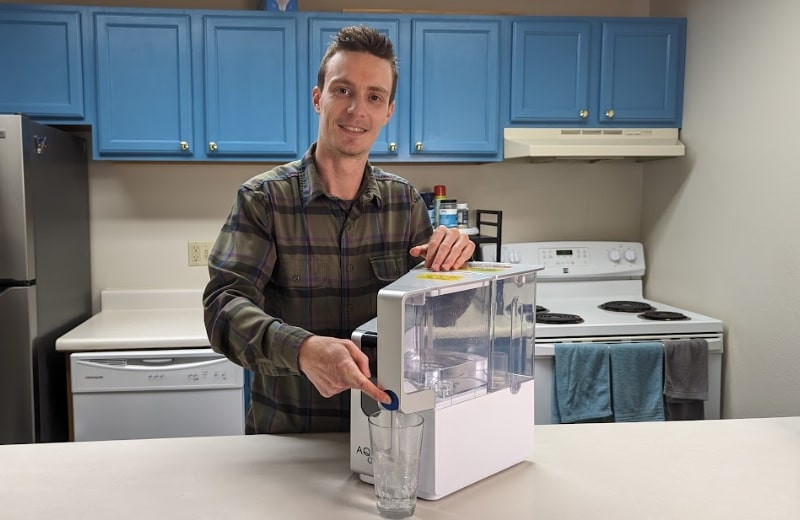
The AquaTru is made from BPA- and BPS-free Tritan plastic, and we noted that the unit construction seems robust and sturdy.
It also has certifications for materials safety and structural integrity, as well as an NSF 372 certification for lead-free design—a combination that no other RO system we tested has obtained.
While the unit isn’t as tech-heavy as many of the other countertop systems we tested, it ticked all our boxes in terms of functionality, durability, and practicality. As a result, it achieved a 10.00 score in this category.
Easy Setup & Maintenance
The AquaTru was also one of the only reverse osmosis systems that achieved the top setup score of 10.00, thanks to its countertop plug-and-play design. It arrived pre-installed, so we simply inserted the filters and followed the simple priming process.
We also found maintenance quick and easy. We awarded the filter a 9.75 score in this category, only slightly lower due to the additional maintenance tasks that any countertop system requires (emptying, filling, and washing out the water tanks when needed). There are three filters inside the unit, which have lifespans varying from 6 to 24 months. The unit is very affordable to maintain with an ongoing cost of just $0.11/ gallon.
We also had to periodically empty out the wastewater tank. But of all the countertop RO systems we used, the AquaTru needed the least frequent empties thanks to its impressive 4:1 recovery rate. That’s the best we’ve come across for any reverse osmosis system, meaning that only 1 gallon of water is wasted for every 4 gallons purified.
0.04 GPM Flow Rate
The only point of improvement we identified was the AquaTru’s filtration speed. In our testing, the unit purified 11 cups of water in 15 minutes and 53 seconds, which equated to a flow rate of 0.04 GPM. This pulled the filtration rate score down to 7.00.
Water that’d purified by the AquaTru gets stored in a gravity tank and can be dispensed at the press of a button. We found the speed of dispensing to be slow, and the dispensing time only increased as the tank emptied.
The AquaTru Carafe is a bit different here: its flow rate came in at a slightly slower 0.03 GPM, and the water is filtered into a glass vessel, rather than a plastic tank.
Read the full review here: AquaTru Review
| Criteria | Results |
|---|---|
| Overall Score | 9.54 |
| Health Related Contaminants | 9.90 |
| Aesthetic Related Contaminants | 9.90 |
| Performance Certification | Certified for 100% of reduction claims |
| Filtration Rate | 0.04 GPM |
| Component Quality | Outstanding |
| Component Certification | Exceptional |
| Setup | Exceptional |
| Servicing Requirements | Outstanding |
| Costs | $0.11/ gallon |
| Warranty Length | 1 year |
| Shipping | Free shipping |
| Returns | 30 days |
Cloud RO

Cloud RO received the third-highest performance score after the AquaTru Countertop and Carafe models: 9.25. It’s the best-performing under-sink RO system we tested, reducing all contaminants with health effects in our water and offering a fresh take on the traditional, inefficient under-sink tank-based units. It has a small footprint, and its built-in battery pack means you don’t need to plug it into a power outlet.
Best For
Anyone who prefers being able to purify their tap water on demand with an under-sink RO filtration system, but wants a smaller, more modern, and less wasteful alternative to conventional systems.
Product Specs
| Price | $749 |
| Contaminants Reduced | 200+ |
| Certifications | NSF 58 |
| Process | Carbon + Reverse Osmosis + Remineralization |
| Filter Capacity | Pre/Post Filters 500 gallons, RO membrane 1,500 gallons |
| Annual Cost | ~$200 |
| Warranty | 1 year |
Why It’s Best
We tested Cloud with municipal water in a townhome in Denver, Colorado. The system costs around $750, so it’s costlier than most other under-sink RO filters you’ll come across, but there’s usually a sale knocking $100-$200 off the price.
Cloud comes in a single configuration, with a built-in remineralization filter included. It consists of two units: the main unit, which contains all four filter cartridges and the battery pack, and a 2.8-gallon purified water holding tank.
Significantly Reduced Health-Related Contaminants
When we tested Cloud, a handful of contaminants with possible health effects were detected in our unfiltered water. These included fluoride and two types of disinfection byproducts (detected above the HGL), as well as copper and aluminum.
Our purified water test results showed that Cloud had effectively eliminated fluoride and both disinfection byproducts, as well as aluminum, copper, manganese, molybdenum, and strontium. It also greatly reduced sulfate (by 94%) and barium (by 78%).
That’s a really good result that awarded the system a score of 9.42. But it’s not as thorough as the AquaTru system, which eliminated 100% of all contaminants by comparison. Plus, the system has an NSF certification for TDS reduction, which is a great start, but we’d like to see it obtain certifications for all other contaminants claimed to reduce.
We were pleased that Cloud’s remineralization filter is built-in instead of being an upgrade at an extra cost. Our purified water still contained 93% less calcium, 55% less magnesium, and 90% less sodium than the unfiltered water. But the pH of our water increased from 8.4 to 9.7, and without the remineralization filter, we probably would have seen this decrease.
Smart, Modern Design
Cloud impressed us with its design, especially compared to some of the conventional under-sink systems we’ve tested previously.
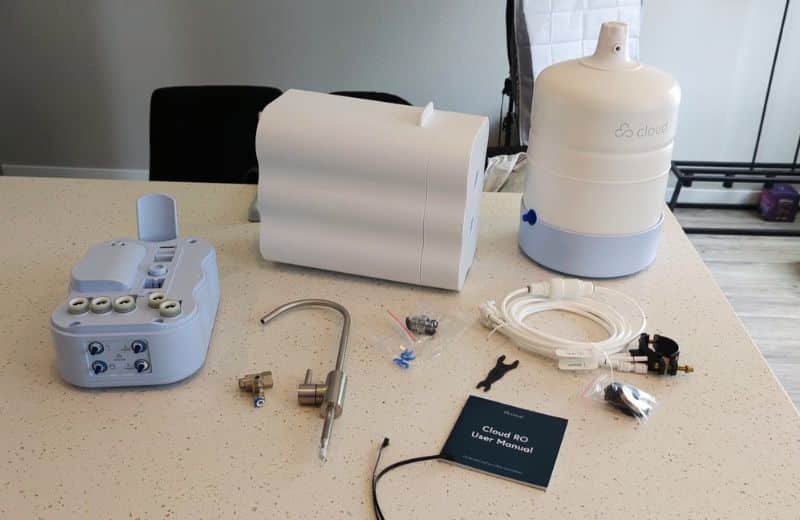
It’s made from BPA-free food-grade plastic and has built-in sensors that track tank volume, water consumption, and water filter lifespan. We downloaded the Cloud app to make it easy to track these stats as well as our purified water’s TDS reading and the system’s battery status, which is a super helpful addition.
Cloud also has a materials safety certification as a component of its NSF 58 performance certification.
Looking at how purified water is delivered, Cloud, like AquaTru, dispenses purified water from a holding tank. But the key difference between the two is that Cloud uses water pressure to deliver the filtered water on demand, providing near-instant access when you turn on the faucet.
The system’s pure-to-wastewater ratio of 1:1 means it’s not as efficient as the AquaTru, but it’s still far more efficient than conventional systems, which typically waste up to 4 gallons of water for every 1 gallon purified.
Under-Sink Installation & Easy Maintenance
Because Cloud is an under-sink RO system, we knew it wouldn’t be as easy to install as the AquaTru countertop system, and it received a lower setup score of 7.50. The system has more components that need to be installed separately, including the dedicated lead-free faucet, tank, and drain line.
But Cloud’s design is fairly minimalist, with all filters contained within a single unit and a detachable base, meaning we could install the base first without having the bulky filter unit getting in the way.
That simplified the installation process somewhat, and we found the instructions in the user manual helpful. But we still needed some DIY skills for tasks like drilling into our countertop to install the dedicated faucet and installing the drain line, and the process was time-consuming.
Once the install was out of the way, maintenance was nice and easy, awarding Cloud a 10.00 score in this category. The system’s app alerted us when replacement filters were needed, saving us the job of making our own calendar reminders.
We calculated that the unit’s ongoing spend is $0.26/ gallon. This is over twice AquaTru’s maintenance spend—a contributing factor was likely Cloud’s battery (which needs replacing every 1.5 years), something that AquaTru doesn’t have.
Read the full review here: Cloud RO Review
| Criteria | Results |
|---|---|
| Overall Score | 9.42 |
| Health Related Contaminants | 9.90 |
| Aesthetic Related Contaminants | 3.50 |
| Performance Certification | Certified for 16% of reduction claims |
| Filtration Rate | 80 GPD |
| Component Quality | Exceptional |
| Component Certification | Certified |
| Setup | Below Average |
| Servicing Requirements | Exceptional |
| Costs | $0.26/ gallon |
| Warranty Length | 1 year |
| Shipping | Free on all orders in the US |
| Returns | 12 month guarantee |
Waterdrop G3 P800

Sticking in the under-sink category, the Waterdrop G3 P800 is the best tankless RO system we’ve tested. This system has an impressively fast water production rate and a modern, high-tech design. It completely removed most of the impurities in our water, and we found it easy and affordable to maintain. It received an overall performance score of 9.21.
Best For
Anyone looking for the best under-sink RO filtration system for a small under-sink space, or folks who simply prefer the convenience of a tankless unit.
Product Specs
| Price | $999 |
| Contaminants Reduced | 10+ |
| Certifications | NSF 42, 53, 58 |
| Process | Sediment + Carbon + RO |
| Filter Capacity | 550/ 1100/ 2900 gallons |
| Annual Cost | ~$145 |
| Warranty | 1 year |
Why It’s Best
We tested the Waterdrop G3 P800 with city water in Parker, Colorado. The unit has one of the highest upfront costs of all the POU systems we tested, at just under $1,100. The price jumps up and down by around $300, and you can sometimes take advantage of a sale, but it’s still a big investment.
So, what are you paying for? The fact that this Waterdrop model is tankless, with an internal pump to send water straight through the system to your faucet, definitely contributes to its high price tag.
The system has a couple of other unique features, too, including a smart faucet, built-in TDS meters, and a UV purifier (with a 99.9% sterilization rate), which protects against bacteria growth within the filters. But disappointingly, there’s no built-in remineralization filter—only the option to buy and install a filter separately from Waterdrop at an extra cost of around $30.
Reduced or Removed All Contaminants With Health Effects
The Waterdrop G3 P800’s contaminant reduction results are comparable to AquaTru’s and Cloud’s, although not quite as impressive.
9 contaminants with health effects were detected in our unfiltered water. The G3 P800 completely removed 6 of these, including lead and arsenic, both detected at concentrations above the Tap Score HGL. It also greatly reduced the other 3 contaminants: strontium, barium, and nitrate.
The system received a 9.50 score for reducing contaminants with health effects, but its overall score for our lab tests was pulled down to 9.20. This was because it reduced the calcium and magnesium minerals in our water by 87%, causing the pH to drop from 7.3 to 6.3 and affecting the filtered water’s aesthetic score. Testing the G3 P800 with the remineralization filter would likely improve this score.
On a more positive note, Waterdrop’s performance certifications were better than Cloud RO’s. The system has been IAPMO certified to NSF 42, for removing chlorine, and NSF 58 and NSF 53, for reducing TDS, fluoride, cadmium, hexavalent chromium, and selenium. Great—but still no certifications across the board like AquaTru.
Modern, High-Quality Design
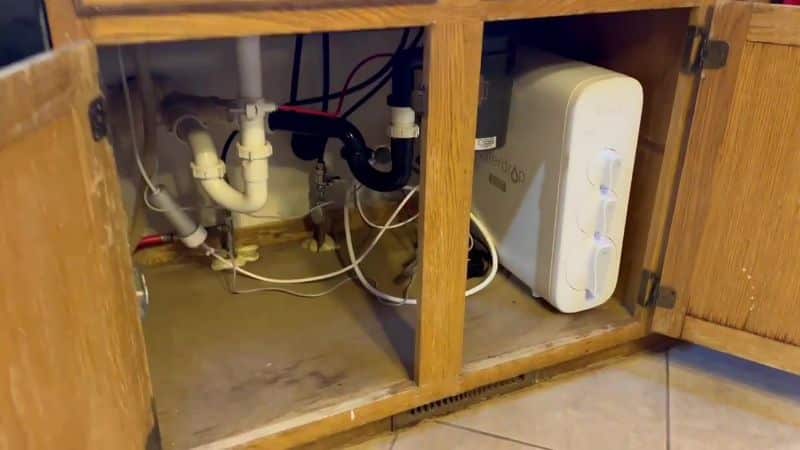
Waterdrop is similar to Cloud when it comes to smart design features. It’s a sleek, space-saving system made from polypropylene and polypropylene, and it received a 9.70 design score from us.
The unit comes with a lead-free smart faucet with an included TDS meter. You can compare the TDS reading at the faucet with the meter on the unit body to check the filters are still working as they should.
We were pleased to see that, like Cloud and AquaTru, Waterdrop has obtained a materials safety certification for the G3 P800 as a component of its NSF performance certifications. It also has an IAPMO certification to NSF Standard 372 for a lead-free design.
Another standout design feature of the G3 P800 is its 800 GPD water production (much higher than you’d actually need), awarding it a 10.00 score from us. And because of its high flow design, the system’s 3:1 efficiency ratio is also great, especially for a tankless system. This makes it a close contender to the AquaTru (with a 4:1 pure-to-wastewater ratio).
However, a setback of all tankless under-sink RO systems is that they’re susceptible to TDS creep, which can affect their water output and performance efficiency. We’ve discussed TDS creep in more detail here.
Time-Consuming Setup But Easy to Maintain
The G3 P800 is tankless, but the installation process was similar to installing Cloud, minus the water-holding tank.
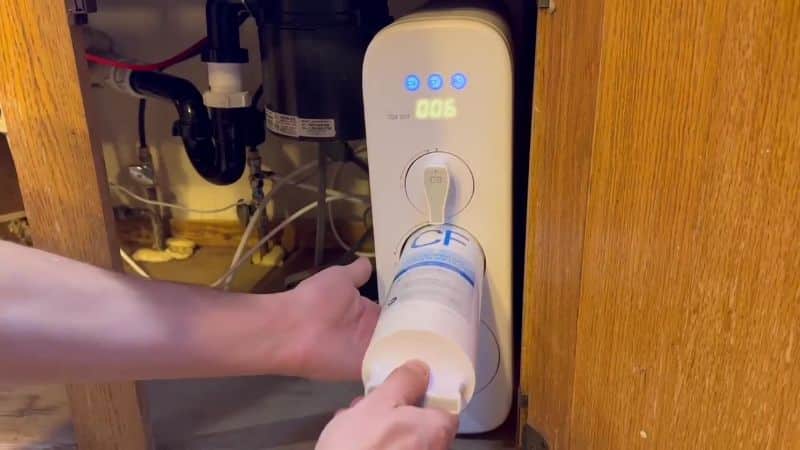
That meant we encountered a lot of the same challenges, including installing the drain line and dedicated faucet. The lower 7.00 setup score reflected the additional time and effort it took us to install the system.
But, like Cloud, Waterdrop’s model is designed to be as easy to install as possible. All three filters (a carbon block and sediment pre-filter, an activated carbon coconut filter, and a semi-permeable RO membrane) are contained within the main body of the unit. This minimized the individual connections we needed to make.
Maintenance was much easier, and we awarded Waterdrop a 10.00 score in this category. We knew when to replace the filters thanks to the built-in filter change reminder. Without the remineralization filter, the system’s ongoing maintenance cost came in at just $0.11/ gallon (or $0.13/ gallon with the filter).
Read the full review: Waterdrop G3 P800 Review
| Criteria | Results |
|---|---|
| Overall Score | 9.21 |
| Health Related Contaminants | 9.50 |
| Aesthetic Related Contaminants | 3.50 |
| Performance Certification | NSF 42, 53, 58 |
| Filtration Rate | 800 GPD |
| Component Quality | Outstanding |
| Component Certification | Certified |
| Setup | Weak |
| Servicing Requirements | Exceptional |
| Costs | $0.11/ gallon |
| Warranty Length | 1 year |
| Shipping | Free shipping to lower 48 states |
| Returns | 30 days |
Waterdrop N1

Another countertop RO system that we had a great experience with was the Waterdrop N1. This did a superb job eliminating nearly everything from our water, and we were pleased with its efficient 3:1 efficiency ratio. But, unlike AquaTru, it’s not certified for its performance or design, and that’s what knocked it down to fourth place, with an overall performance score of 9.17.
Best For
Anyone looking for the a reverse osmosis system that delivers water on demand but offers the convenience and space-saving benefits of a tankless unit.
Product Specs
| Price | $299 |
| Contaminants Reduced | 10+ |
| Certifications | – (Not specified) |
| Process | PP Cotton + Carbon Block + RO Membrane |
| Filter Capacity | 75 GPD |
| Annual Cost | ~$70 |
| Warranty | 1 year |
Why It’s Best
A major advantage of the Waterdrop N1 is its affordable upfront cost. At the time of our review, it cost just under $300, and there are often sales on the Waterdrop website bringing the price down to closer to $200. That makes it around $150 cheaper than AquaTru’s base model while offering a very similar performance.
The unit is available in just one configuration, so, unlike AquaTru, it doesn’t have a remineralization upgrade—a setback if you want to increase the pH and mineral content of your purified water.
Greatly Reduced Or Removed All Contaminants
Our unfiltered water contained trace levels of 12 contaminants with possible health effects, including fluoride, lead, uranium (all detected above the HGL), nitrate, strontium, and sulfate. The N1 completely removed 10 of these contaminants, and greatly reduced fluoride by 93% and sodium by 78%.
The system also reduced calcium and magnesium by 91%. With no remineralization filter, we couldn’t reintroduce these lost minerals during the filtration process itself. The good news is that the pH of our water only dropped slightly, from 7.4 to 7.0, so not as substantial as with many of the other non-remineralization RO systems we tested.
Disappointingly, the N1 hasn’t been certified for reducing any contaminants that Waterdrop claims it can reduce, so if you’re only interested in systems with official proof of performance, you may want to strike this one off your list.
Modern Take on AquaTru’s Design
The N1 has a sleeker, more modern look and feel than AquaTru’s comparable countertop RO system. It has a smart display screen that offers insight into the N1’s performance, and is mostly made from polypropylene plastics with some stainless steel components. Its slim, rectangular build makes it easier to fit on a countertop compared to AquaTru’s wider hexagonal footprint.

But the unit’s smaller size has its setbacks: there’s only room to fit two filters (a pp cotton/carbon block filter and an RO membrane), and there’s no option to upgrade a filter to a remineralization version as with AquaTru. Plus, the N1 isn’t certified for materials safety, which pulled down its design score to 8.10.
Water dispensing is another design difference between this Waterdrop model and the AquaTru. While AquaTru uses gravity dispensing, the N1 pumps water straight through the filters and out of the dispenser, rather than storing it in a tank. We measured its flow rate at 0.1 GPM, which is slow—it received a score of 7.5 as a result.
Hassle-Free Setup & Maintenance
Like AquaTru, the N1 is a plug-and-play system with most components pre-installed inside the housing. We just had to plug in the power cord and flush the filters (as an extra convenience, this is an automated process, and manual priming isn’t required).

While setup was super easy, the flushing process took just under an hour, so we awarded the system a 9.50 score due to this time-consuming aspect.
As for maintenance, the system received the highest score of 10.00. We don’t think there were any ways that Waterdrop could improve on what it offers here.
The unit’s digital screen displayed when we needed to refill the tank and replace the filters, and we could confirm that the filters were working properly by checking the on-screen TDS reading.
Swapping out the filters was quick and easy, and the internal UV light sanitizes the water tank, reducing the frequency of cleaning required. The N1 has a cost of $0.09/ gallon for both filters, so it’s one of the most affordable RO systems upfront and to maintain.
Read the full review: Waterdrop N1 Review
| Criteria | Results |
|---|---|
| Overall Score | 9.03 |
| Health Related Contaminants | 9.60 |
| Aesthetic Related Contaminants | 9.90 |
| Performance Certification | Not certified for any reduction claims |
| Filtration Rate | 0.1 GPM |
| Component Quality | Fair |
| Component Certification | Not certified |
| Setup | Outstanding |
| Servicing Requirements | Exceptional |
| Costs | $0.09/ gallon |
| Warranty Length | 1 year |
| Shipping | Free shipping to lower 48 states |
| Returns | 30 days |
RKIN U1

The RKIN U1 received the lowest performance score score (8.83) of all the RO systems we’ve shortlisted for this guide—but the competition was tough, and there are a few unique features of this system that might make it a winner for you. It’s the most advanced and high-tech countertop reverse osmosis system we’ve tested, with the ability to dispense purified water at any temperature, as well as built-in remineralization and hydrogen infusion stages. Plus, it eliminated most contaminants in our testing.
Best For
Anyone looking to invest in a feature-heavy countertop unit with all the capabilities of a modern RO system that you could ask for.
Product Specs
| Price | $749.95 |
| Contaminants Reduced | 99% of contaminants |
| Certifications | NSF 58 (in progress) |
| Process | Mechanical + Carbon + RO + Alkaline + Hydrogen infusion |
| Filter Capacity | 6, 12, 24 months |
| Annual Cost | ~$180 |
| Warranty | 1 year |
Eliminated Fluoride, Lead, & More
The water that we used to test the U1 contained 3 contaminants with health effects in concentrations above the HGL: fluoride, lead, and uranium. 8 other contaminants were also detected below the HGL, including copper, nitrate, and strontium.
The U1 did an exceptional job of eliminating most of these contaminants, and greatly reducing the others. The only surprising outcome was that strontium actually increased by 2,140% from just 0.1 to 2.42 PPM (still below the HGL of 3 PPM). Our theory is that there are traces of strontium in the remineralization filter media.
And speaking of remineralization, the U1 still reduced 84% calcium and 93% magnesium overall, even with the mineral-adding filter. But the pH of our water increased from 7.4 to 8.1, and our water quality was further improved by the hydrogen infusion stage.
The only letdown here is that the U1 still isn’t performance certified, even though we heard that RKIN had applied for an NSF 58 certification back in 2022.
Modern, Advanced Design
The RKIN U1 is like a larger, upgraded version of the Waterdrop N1 when we look at its design. It got a 7.50 score in this category, pulled down by its lack of a design certification, but there were a lot of features of the U1 that we appreciated. The RKIN U1 is like a larger, upgraded version of the Waterdrop N1 when we look at its design. It got a 7.50 score in this category, pulled down by its lack of a design certification, but there were a lot of features of the U1 that we appreciated.
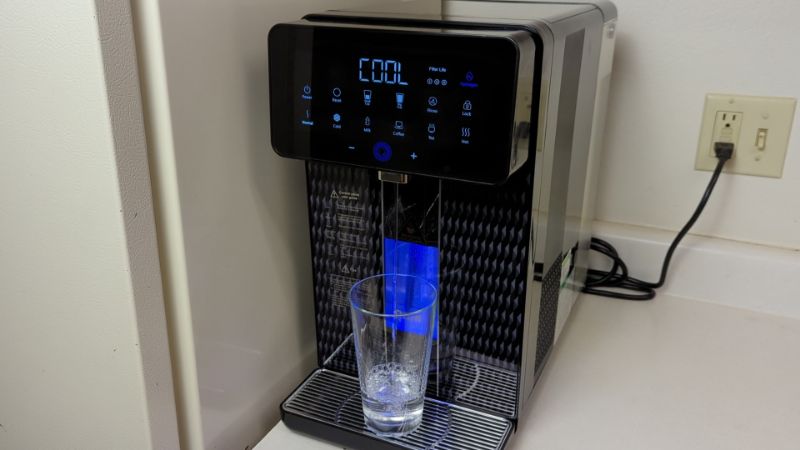
This is another countertop unit with a digital display panel, and there are a lot of different options and presets to choose from. Getting used to all the different icons and buttons is a learning cuve, but it’s worth it for the ability to tailor your water dispensing to your exact preferences.
The unit is made from BPA-free polypropylene, and RKIN has made design decisions to prevent water’s contact with plastic as much as possible. For instance, the plastic nozzle has an inner silicone tube, so water only comes in contact with the solicone.
The U1 is another system that dispenses water via an internal pump, and its filtration rate measured in at 0.07 GPM, nearly twice AquaTru’s measured flow.
We were less impressed with the unit’s 1:1 efficiency ratio. While still efficient, we think it could be better, especially as all the other shortlisted countertop RO systems have recovery rates of at least 3:1.
Simple Setup & Maintenance
As expected for a countertop system, the U1 was quick and easy to install. It just needed to be plugged in and set up following just 6 steps in the included user manual.
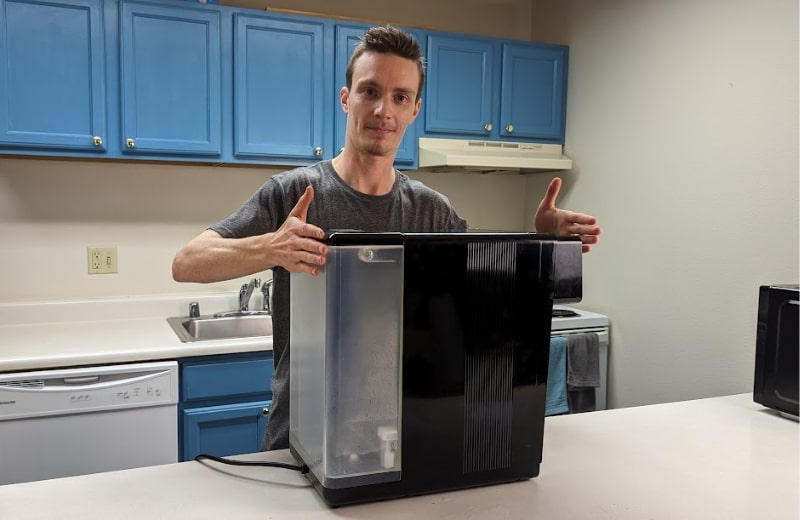
Like the Waterdrop N1, the U1 has an automated flush button that can be activated by pressing a button, so we didn’t have to waste time manually priming the filters. It received a 10.00 score for its no-hassle installation.
Maintenance was equally simple, with just three filters to replace (with lifespans of 1-4 years): the CF filter, the RO filter, and the PAC filter. There’s a filter life icon for each of the filters, which changes color to indicate the filter status and let you know when new filters are needed.
As with the other countertop systems, we had to dump the wastewater when the tank got full, which was a bit more of a regular task due to the U1’s less efficient 1:1 recovery rate. We also found replacing the hydrogen module to be a bit of a hassle, involving turning the unit on its side and using a screwdriver and special key for this purpose.
But at least we didn’t have to worry about taking the system apart to clean inside. There’s an automatic “rinse” setting, which periodically drains the system and flushes the filters, and a built-in UV light, which prevents microbial formation in the stored water when it’s not in use.
The unit has an ongoing servicing cost of just $0.0809/gallon, and we awarded it an overall score of 9.75 in the maintenance category.
Read full review: RKIN U1 Review
| Criteria | Results |
|---|---|
| Overall Score | 8.83 |
| Health Related Contaminants | 9.30 |
| Aesthetic Related Contaminants | 9.90 |
| Performance Certification | Not certified for any reduction claims |
| Filtration Rate | 0.07 GPM |
| Component Quality | Outstanding |
| Component Certification | Not certified |
| Setup | Exceptional |
| Servicing Requirements | Exceptional |
| Costs | $0.08/gallon |
| Warranty Length | 1 year |
| Shipping | Free shipping on orders over $175 to lower 48 states |
| Returns | 30 days |
How to Select the Best Reverse Osmosis System
The best reverse osmosis system for you depends on your budget, contaminant removal goals, and other desired outcomes. Make sure to consider all the factors that could influence your purchasing decision before you start shopping.
Here, we’ve shared everything we personally considered – which you will also find helpful to consider – when deciding on the best reverse osmosis filtration system for different situations.
- Contaminants in source water – First, we considered the contaminants in our source water. We know from regular testing that our water contains trace levels of fluoride, lead, nitrate, disinfection byproducts, minerals and salts, and other impurities. Our advice is to test your water to find out what it contains and what you want to remove. Generally, the greater the total dissolved solids concentration, the faster the filters will become clogged. Plus, an excess of certain minerals, like hardness ions and iron, might damage the RO membrane. We generally only review RO systems for city water, but if you’re on a private well and want to benefit from RO purification, our advice is to install suitable pre-filtration (such as sediment or iron filters, or water softeners) upstream of the reverse osmosis system.
- System type – We identified four key types of reverse osmosis water filters: tank-based under-sink systems, tankless under-sink systems, countertop systems, and whole-home systems. Of these system types, we reviewed the first three. We’ve made a separate guide for whole-house RO systems since there are specific factors that only apply to these units.
- Efficiency ratio – We also considered the efficiency ratio of the systems we were reviewing, or the gallons of water that were wasted for every gallon purified. Conventional RO systems generally waste 3-4 gallons of water for every 1 gallon purified, but we determined that many of the modern systems have much better efficiency ratios of 1:1 gallons to 4:1 gallons, meaning that only one gallon of water is wasted for every 1-4 gallons of water purified.
- Water usage – This was something that we considered when reviewing the countertop and tank-based systems in particular. Our aim was to find systems that would offer a practical, convenient solution for the average family of 2-4. We found that using more water than average might have effects on the system. For instance, a tank-based system stores drinking water to be delivered to your faucet, and using too much water at once could empty the storage tank. If your RO water requirements are a lot higher than the average family’s, we recommend a tankless under-sink water filtration system that delivers purified water on demand, rather than a countertop unit with tanks that you’ll need to empty and fill constantly.
- Water pressure – In our research, we found that the reverse osmosis process can only work effectively when enough pressure is applied to force the water through the semi-permeable membrane (the RO filter) to the other side. Water pressure isn’t an issue with countertop systems, which use an electric pump to send water through the system. But for under-sink reverse osmosis filters, most manufacturers say that your water pressure should be at least 60 PSI for optimal functioning. We strongly advise installing a pressure booster pump if your water pressure is lower than this.
- Storage capacity – For RO systems with a storage tank (both tank-based under-sink systems and countertop systems), storage capacity was something else for us to compare and consider. We found that most under-sink systems had a storage tank of around 1.5-3 gallons, while the countertop systems could hold around 0.5-0.75 gallons of filtered water.
- Remineralization needs – We knew that reverse osmosis, being the most thorough water treatment process, removed everything from water, including healthy minerals and salts. While we can get magnesium and calcium from other sources, obtaining them through drinking water is an easy way to ensure we’re getting our daily mineral requirements. When choosing the systems for this guide, we looked for those with a built-in remineralization filter or at least an optional add-on filter, allowing for minerals to be added back into the filtered water before dispensing.
Why Buy A Reverse Osmosis Water Filter?
First, we wanted to know why we, or anybody else, should invest in a reverse osmosis water filter.
To learn this, we researched water quality data to understand how our drinking water might be impacted by common contaminants in the US.
Water Quality Facts and Figures
In our research, we came across a number of studies that supported our belief that water purification could be beneficial to the average US homeowner on a city drinking water supply. Some of the most notable studies were:
- A USGS study, which found that just under half of the nation’s tap water was contaminated with at least one type of PFAS chemical. PFAS are a group of synthetic chemicals with several known health effects, including cancer.
- An NRDC analysis, which found detectable lead levels in over half of the US population’s water supplies in the 2018-2020 period.
- A Consumer Reports investigation, conducted with The Guardian, which discovered “alarming” levels of PFAS, lead, and arsenic in water samples obtained from municipal supplies across the US.
The research and data confirmed to us that water quality is something to be concerned about in the US, despite how our local water utilities may try to assure us otherwise. The reality is that many of the contaminants in our drinking water aren’t regulated, and organizations like the Environmental Working Group argue that the regulations that are in place simply aren’t strict enough to protect public health. Plus, contaminants like lead and other heavy metals may enter our drinking water supplies after filtration at the treatment plant. Since we can’t rely on our local authorities to keep us safe from these impurities, at-home water treatment is the best alternative.
Why is reverse osmosis particularly beneficial for removing contaminants? This water purification method is more thorough and comprehensive than non-RO water filtration, with numerous studies documenting its ability to effectively remove a range of contaminants, including:
- Lead and arsenic – This study concluded that RO “guarantees” the rejection of more than 99% rejection of these metals
- PFAS – This review noted that reverse osmosis offered a rejection rate as high as >99 % for these chemicals
- Disinfection byproducts – This study found that reverse osmosis achieved up to 80.8% removals for most disinfection byproducts.
We concluded that reverse osmosis was one of the most reliable solutions for removing the majority of drinking water contaminants, and was a good choice for people who preferred to spend more money upfront on the most comprehensive treatment option.
Advantages of Reverse Osmosis Filter Systems
A reverse osmosis water filtration system boasts a number of benefits that set it apart from alternative water treatment methods. Based on our own experience testing and reviewing reverse osmosis filters for this guide, we identified the following advantages of these systems:
- Very thorough contaminant removal: The RO process can remove the majority of impurities and pollutants, including chlorine, pesticides, nitrates, bacteria, fluoride, pharmaceuticals, lead, PFAS, and arsenic. Reverse osmosis is more thorough than any other filtration method because it uses a semi-permeable membrane, with tiny pores that reject contaminants as small as microorganisms.
- Improve water quality and safety: By removing the majority of TDS, an RO system can significantly improve the quality of your water and eliminate the safety concerns associated with certain trace contaminants.
- Easy to maintain: A reverse osmosis water filtration system is fairly simple in design, so you won’t need to worry about taking everything apart for a stringent regular cleaning process. There are usually 2-4 filters to replace, but this is easy to do and only required every 6-24 months on most modern systems.
- Cost-effective: While RO systems are more expensive than other filter types, when you compare their performance to these alternative options, the cost is more than worth it. With a reverse osmosis system, you’ll no longer need to spend money on filtered water from the supermarket, so the unit should pay for itself within a few years.
- Upgrades & smart features available: Many of the modern reverse osmosis systems we’ve reviewed today have numerous built-in smart features, like TDS and filter life monitoring, remineralization, and hot and cold water dispensing.
Frequently Asked Questions
How much does a reverse osmosis system cost to install?
If you choose to install a reverse osmosis system yourself, there should be no extra cost to install (aside from possibly the cost of a few plumbing supplies, depending on your under-sink plumbing situation). If you choose to hire a plumber to handle the installation process, the cost to do so is usually between $100 and $350, depending on the complexity of the job.
How long does a reverse osmosis system last?
A reverse osmosis system generally lasts 10+ years with proper care and maintenance. During this time, you might need to replace parts every year or two, such as your filters, O-rings, and any moving parts.
How much wastewater do reverse osmosis systems produce?
Conventional reverse osmosis water filters waste around 4 gallons of water for every 1 gallon purified. The good news is that newer RO water filters are far less wasteful – they typically only waste 1 gallon for every 1-4 gallons purified.
What kind of reverse osmosis system is best?
The kind of reverse osmosis system that’s best depends on your personal preferences and situation. For instance, you might prefer a conventional tank-based under-sink system with a storage tank if you want instant access to filtered water when you turn on the tap. Or, if you want to save space, you might opt for a tankless under-sink system. Alternatively, if you don’t want the hassle of an install, you can go for a countertop RO system.
About Our Experts
Brian Campbell, WaterFilterGuru.com’s Founder and WQA Certified Water Treatment Specialist, researched, tested, and reviewed the reverse osmosis systems featured here. Check out his author bio below.

